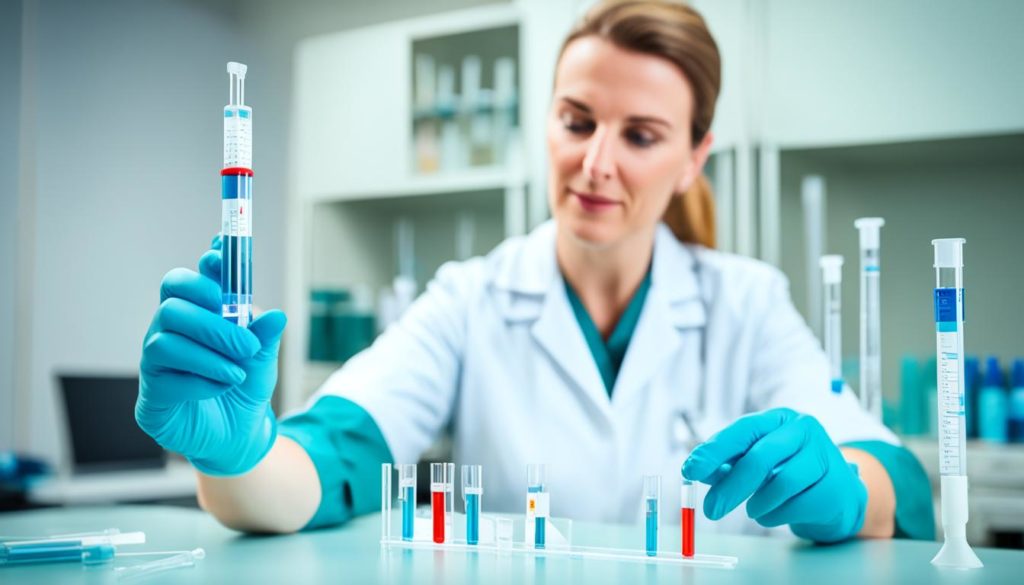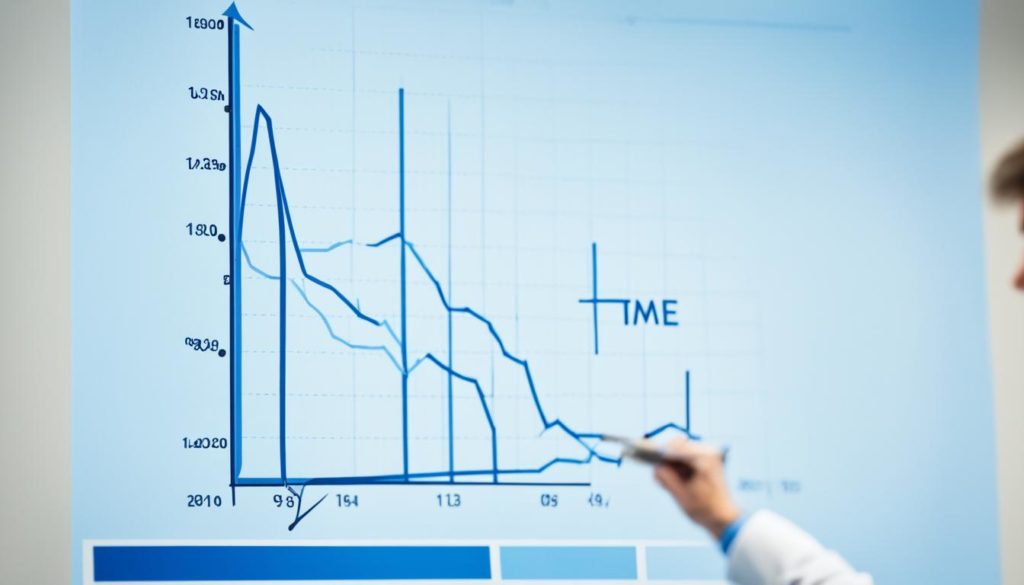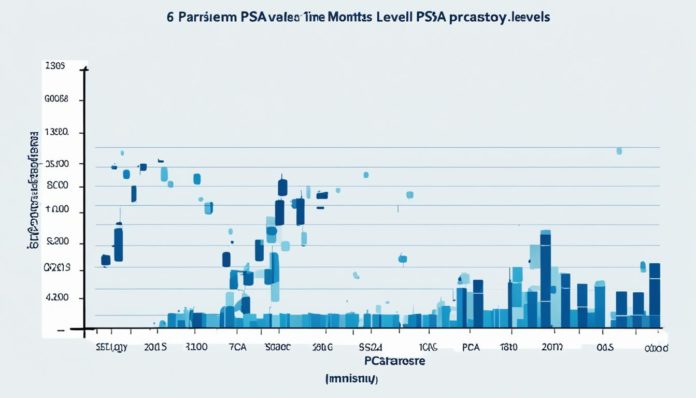Did you know after a prostatectomy, 90% of patients have undetectable PSA levels within a few months? This fact highlights how critical it is to watch PSA levels after surgery. For those recovering from prostate cancer treatment, monitoring PSA is key. It tells us if the cancer has returned or if treatment worked.
The prostate-specific antigen (PSA) is made by prostate cells. After a prostatectomy, successful treatment means PSA levels usually can’t be detected. But, if PSA levels start to rise, it might mean cancer cells are still there or have come back. This situation calls for more tests and possibly more treatment.
Knowing about PSA levels after surgery is important. It helps patients and doctors make smart choices about prostate cancer care. Keep reading to learn more about why checking PSA levels after prostatectomy matters for long-term health.
Key Takeaways
- Monitoring PSA levels post-prostatectomy is crucial for assessing treatment efficacy.
- Undetectable PSA levels typically indicate successful prostate cancer treatment.
- Rising PSA levels post-surgery may signal the presence of remaining or recurrent cancer cells.
- Continuous PSA monitoring aids in managing prostatectomy recovery and long-term health.
- Understanding PSA fluctuations can help tailor further treatment interventions.
What Are PSA Levels?
PSA levels are key in checking prostate health. They are found through the PSA test, showing how much prostate-specific antigen is in the blood. This is very important for men who had prostate surgery or other treatments.
Definition and Importance

The PSA test measures prostate-specific antigen, a protein made by the prostate. If PSA levels are high, it might mean problems like prostate cancer or an enlarged prostate. Keeping track of PSA levels helps doctors understand a patient’s prostate health better.
PSA Levels and Prostate Health
Checking PSA levels often is crucial after prostate surgery or treatment. A big drop in levels is usually good. But, if levels stay the same or go up, it could mean the prostate issue is still there or has come back. Knowing these changes lets patients and doctors decide on the next steps.
Why Monitor PSA Levels Post-Prostatectomy?
Checking PSA levels after a prostatectomy is key to good post-op care. It shows if the cancer treatment worked well and if all cancer cells were removed. Keeping an eye on PSA helps catch any return of cancer early, which can do a lot for successful treatment.

Indicators of Treatment Success
PSA levels should become very low after surgery. This drop means the surgery likely got rid of the cancer. If there’s no PSA later on, it points to successful removal of the PSA source.
Detecting Cancer Recurrence
Watching PSA levels is crucial for spotting cancer’s return. A rise in PSA after surgery can signal cancer might be back. With ongoing checks, doctors can act fast if there’s any sign of trouble. They might use treatments like radiation or hormone therapy.
PSA Monitoring Frequency
How often to check PSA depends on each person’s risk and initial PSA levels. Usually, patients get tested every few months for the first years after surgery. If PSA stays low and hidden, testing can happen once a year. Staying consistent with PSA tests after surgery is important to watch out for cancer’s return and mark treatment success.
Expected PSA Levels After Prostatectomy
After a prostatectomy, your PSA levels should quickly drop to almost zero within weeks. This means that the prostate gland, which was making the PSA, is gone. Keeping track of these levels is key to know if the surgery went well and to check on how the prostatectomy recovery is going.
Initial Drop
The PSA levels post-prostatectomy should quickly fall. They usually go below 0.1 ng/mL. This big drop soon after the surgery shows the prostate has been removed successfully, stopping the main source of PSA.
Follow-Up Testing Timeline
After PSA levels drop, it’s important to keep checking them. This helps make sure the prostatectomy recovery stays on track and catches any return of cancer early. The first check is often 1 to 3 months after surgery. Then, tests should happen every 6 to 12 months for at least five years, or more often if there’s a higher risk.
When PSA Levels Remain Detectable
After a prostatectomy, the aim is to lower PSA levels to a point where they’re not noticeable. But sometimes, men see their PSA levels stay above zero even after surgery. Knowing what this means is key to taking care of your prostate health going forward.
How we look at these PSA levels affects the next steps in treatment and check-ups.
Understanding Residual PSA
Even after the prostate is removed, tiny bits of prostate tissue might still be there. These remnants can release PSA, leading to detectable levels in your blood. This doesn’t always mean cancer is present, but it does mean you need to keep an eye on it.
Interpretation of Low-Level PSA
When PSA levels are low but still there, it’s a bit of a puzzle. We need to watch these levels over time to see if they hint at cancer returning. The type of PSA test and unique patient factors play big roles in these PSA changes.
Consulting with Your Doctor
Talking to your doctor is crucial if your PSA levels don’t fall after surgery. Tailoring the management plan to you is vital. Stay in close contact with your doctor to make sure you get the right tests or treatments when needed.
PSA Levels Post-Prostatectomy
After a prostatectomy, it’s key to keep an eye on PSA levels. These levels help spot cancer’s possible return. They show us how fast the situation is changing.
Understanding Biochemical Recurrence
When PSA levels go up after surgery, it might mean cancer cells are still around. Catching this rise early lets doctors act fast. This is why knowing about biochemical recurrence matters so much.
PSA Doubling Time and Its Significance
PSA doubling time tells us how quickly PSA levels are rising. If this time is short, the cancer might be more aggressive. This means it’s really important for doctors to keep a close watch.
What Causes PSA Levels to Rise After Prostatectomy?
It’s essential to know why PSA levels go up after prostatectomy. This is key for cancer treatment and staying healthy. Some reasons include not all prostate tissue being removed during surgery. This leaves cells that keep making PSA. Also, cancer cells may spread microscopically before treatment begins, leading to more issues.
Rising PSA levels can also come from the regrowth of benign or cancerous prostate cells. This can happen even after surgery. It means PSA production goes up, showing higher test results. For accurate diagnosis, doctors use advanced imaging methods to find the cause and plan treatment.
Monitoring PSA levels closely and thorough diagnostics are vital. They help effectively manage and treat prostate cancer.
How to Interpret Rising PSA Levels
Understanding rising PSA levels after prostatectomy is key. It helps with effective monitoring. It also aids in timing prostate cancer treatment right. A major factor here is PSA velocity.
The Role of PSA Velocity
PSA velocity means how fast PSA levels increase over time. It helps tell apart normal fluctuations from possible cancer comeback. A high PSA velocity might signal cancer’s return. This requires more tests and could change treatment plans.
Importance of Consistent Lab Testing
For right PSA monitoring, lab test consistency is vital. Different lab practices can confuse PSA trends. This might lead to wrong diagnosis or unneeded treatments. Testing often, using the same lab and methods, keeps PSA velocity data trustworthy. This ensures decisions on prostate cancer treatment are well-guided.
Advancements in PSA Monitoring
Technological advances in PSA monitoring have changed how doctors detect and treat prostate cancer coming back. By using new imaging techniques, we can now find cancer earlier at lower PSA levels. This accuracy is key in fighting prostate cancer effectively.
New Imaging Techniques
A major advancement is the new imaging technique called the PSMA PET scan. It greatly improves how we spot cancer cells by showing where lots of Prostate-Specific Membrane Antigen are. Thanks to PSMA PET scans, doctors can make better treatment plans by knowing exactly where the cancer is.
PSMA PET Scans
PSMA PET scans are a big step forward in monitoring PSA. They use a special radiotracer that attaches to PSMA proteins on prostate cancer cells. This creates a clear picture that shows even tiny cancer spots. This helps doctors find and treat cancer much sooner than before. Their high accuracy makes PSMA PET scans essential in the fight against prostate cancer.
Implications of Different PSA Thresholds
Checking PSA levels after prostate surgery is key in watching for prostate cancer coming back. It’s key to grasp that PSA thresholds show different levels of worry and call for varied responses from doctors.
For example, a PSA level of 0.2 ng/mL or more after surgery suggests cancer might have returned. On the other hand, after radiation therapy, a jump of 2.0 ng/mL above the lowest point signals concern. These PSA thresholds stress the need for plans tailored to each patient to effectively handle a possible return of cancer.
| PSA Threshold | Indication | Recommended Action |
|---|---|---|
| 0.2 ng/mL post-prostatectomy | Potential Cancer Recurrence | Further Diagnostic Imaging & Consultation |
| 2.0 ng/mL rise post-radiation therapy | Potential Cancer Recurrence | Consider Additional Treatment Options |
Knowing about PSA thresholds helps doctors make smart choices. This supports close tracking and fast action for prostate cancer patients. It’s also key to involve patients in decisions. This way, they understand their PSA levels and what those numbers mean for their health in the future.
Factors Affecting PSA Test Accuracy
PSA test accuracy is key for watching prostate health after surgery. Many elements can change PSA test scores, like lab differences and body changes. Knowing these elements helps get reliable scores.
Lab Variations
Different labs process PSA tests in their own ways, causing varied results. It’s important to stick with one lab for PSA tests. This helps doctors and patients track PSA levels accurately over time. It ensures a clear picture of prostate health.
Physiological Fluctuations
Body conditions can also shift PSA levels. Things like swelling, recent medical steps, or even sexual activity can impact results. These changes might lead to confusing outcomes. Knowing this helps everyone make smarter choices about PSA test readings.
Here’s a brief comparison:
| Factor | Impact on PSA Test Accuracy | Recommendation |
|---|---|---|
| Lab Variations | Discrepant results due to different processing methods | Use the same lab consistently |
| Physiological Fluctuations | Influence from inflammation, procedures, ejaculation | Avoid these activities before testing |
Conclusion
After PSA levels post-prostatectomy are monitored, it is crucial in managing prostate cancer. Tests should be regular and accurate. They show if treatment worked and if cancer might be coming back. Knowing about biochemical recurrence and PSA doubling time matters too.
It’s important to know what affects patient outcomes. This helps patients and doctors make better plans for monitoring and follow-up care.
Research shows that keeping an eye on PSA levels is key to catch any rise. This rise could mean the cancer is back. Advanced imaging, like PSMA PET scans, help find where the cancer has returned.
Making wise choices about PSA levels and when to act is important. This helps handle any cancer return effectively.
Teaching patients about PSA monitoring and talking openly with doctors improves prostate cancer care. It helps patients feel more at ease. They know their care is tailored to them. Being informed and active about PSA levels post-prostatectomy helps survivors live better. They face their post-treatment life with more confidence and understanding.
FAQ
What are PSA levels?
PSA levels measure the presence of a specific protein in the blood, produced by prostate cells. High levels may point to prostate cancer or other prostate issues.
Why are PSA levels important for prostate health?
PSA levels are key to understanding prostate health. They can signal prostate cancer, benign prostatic hyperplasia, or inflammation. Checking PSA levels aids in the diagnosis and management of prostate conditions.
Why is it essential to monitor PSA levels post-prostatectomy?
After prostate surgery, it’s vital to keep an eye on PSA levels. This helps check the treatment’s success and spot any signs of cancer coming back. Continuous checks give insights into the patient’s health over time.
What do PSA levels indicate regarding treatment success?
Post-surgery, a significant drop in PSA levels suggests the procedure worked well. If PSA levels stay low, it likely means the cancer is gone.
How often should PSA levels be monitored post-prostatectomy?
Initially, PSA levels are checked every few months after surgery. If they remain stable, tests may then be done once a year.
What is the expected timeline for PSA level changes after prostatectomy?
PSA levels should fall sharply soon after surgery. The first test is often done 1 to 3 months later. Then, check-ups follow every 6 to 12 months.
What does it mean if PSA levels remain detectable after surgery?
If PSA can still be detected post-surgery, it might mean some prostate cells are left, or due to lab sensitivity. This situation demands close observation.
What is biochemical recurrence in PSA levels?
Biochemical recurrence means PSA levels are rising, hinting at a possible return of prostate cancer. This is checked by looking at PSA levels over time.
Why is PSA doubling time significant?
The time it takes for PSA levels to double matters. A quick doubling suggests more serious cancer and needs fast action.
What causes rising PSA levels after a prostatectomy?
After surgery, rising PSA may be due to not all prostate tissue being removed, cancer spread before treatment, or growth of left-behind cells. Tests are required to find out why.
How should rising PSA levels be interpreted?
The rate of increase in PSA levels helps tell apart benign from concerning signs. Regular testing is needed for accurate reading of PSA trends.
What advancements in PSA monitoring are available?
New scans, like PSMA PET, have improved detecting prostate cancer’s return at lower PSA levels. These technical advances allow for more precise evaluations.
What are the implications of different PSA thresholds post-prostatectomy?
After surgery, specific PSA levels raise different concerns. A PSA higher than 0.2 ng/mL often signals a cancer return, needing tailored care strategies.
What factors affect PSA test accuracy?
The accuracy of PSA tests can vary with lab techniques and physical conditions like inflammation. Using the same lab for all PSA tests ensures consistent results.


